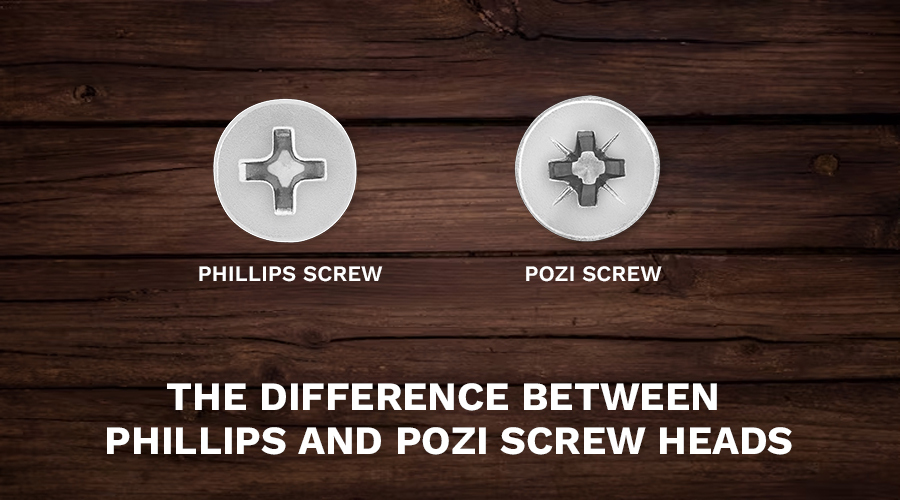Screws are the unsung heroes of construction and DIY projects, holding together our furniture, appliances, and structures. Among the many types of screws, are the Phillips and Pozi screw heads, each with their special qualities and uses. In this blog, we’ll take a closer look at these two common screw head designs, exploring what makes them different and understanding when each one is the best fit for specific tasks. Let’s dive into the details to uncover the unique strengths of Phillips head screws and Pozi Screw Heads.
Phillips Screw Heads
Named in honour of its inventor, Henry F. Phillips, the Phillips screw head stands out with its distinctive cross-shaped recess, featuring four points strategically placed. This innovative design aimed to revolutionize torque application and address the prevalent issue of “cam-out” – a scenario where the screwdriver slips out of the screw head during operation. As a testament to its effectiveness, the Phillips screw head has become a must in a myriad of industries and household applications.
A standout characteristic of the Phillips screw head lies in its inherent self-centring property. This feature facilitates a seamless alignment between the screwdriver and the screw during installation. In practical terms, a self-centring screw head minimizes the chances of misalignment or slippage, allowing for a smoother and more precise engagement between the screw and the screwdriver.
To accommodate various applications and screw sizes, Phillips screwdrivers come in a range of sizes, each denoted by numbers ranging from 0 to 4. The numbering system serves as a convenient guide, with larger numbers corresponding to larger screw sizes. This ensures that the Phillips head screw can be effectively employed across a spectrum of tasks, from intricate household projects to larger industrial applications.
Pozi Screw Heads
At a cursory glance, the Pozi screw head shares a resemblance with its Phillips counterpart, featuring a cross-shaped recess. However, what sets it apart is the incorporation of additional lines between the arms, resulting in a total of eight contact points. This deliberate modification is aimed at elevating torque capabilities and further diminishing the occurrence of “cam-out,” where the screwdriver unintentionally slips out of the screw head during operation.
The Pozi drive swiftly gained traction in European regions and beyond, particularly finding widespread application in the construction and furniture industries. The additional lines in the Pozi screw head configuration translate into enhanced torque distribution and reduced likelihood of slippage, contributing to an improved grip. This makes the Pozi drive an exceptional choice for precision and reliability tasks.
The intentional design modifications make the Pozi drive a reliable partner in scenarios where a secure and steadfast connection is imperative, demonstrating that innovation in screw head design can lead to tangible improvements in performance and usability.
Key Differences between Phillips and Pozi Screw Heads
Phillips: Four contact points in a cross shape.
Pozi: Eight contact points, including additional lines between the arms. Resistance to Cam-out:
Phillips: Prone to cam-out, especially under high torque.
Pozi: Offers better resistance to cam-out, making it suitable for heavy-duty applications.
Versatility:
Phillips: Widespread use, especially in the United States.
Pozi: More common in European applications but gaining popularity globally.
Screwdriver Sizes:
Phillips: Numbered from 0 to 4, with larger numbers for larger screws.
Pozi: Numbered similarly to Phillips, but using the correct size for optimal performance is crucial.
Applications:
Phillips: Common in household appliances, electronics, and automotive industries.
Pozi: Preferred in construction, furniture assembly, and other heavy-duty tasks. Choosing the Right Tool for the Job
When confronted with the difference between Phillips and Pozi screw heads, it becomes crucial to evaluate the specific demands of your project meticulously. Despite both designs serving a common fundamental purpose, their subtle distinctions render them more suitable for distinct applications.
For lighter tasks, such as assembling furniture or fixing electronics, Phillips screws may prove adequate. Their versatility and widespread use make them reliable when precision is essential, but the torque demand is relatively moderate. On the contrary, when undertaking more substantial endeavours like construction projects or tasks that necessitate higher torque, opting for Pozi screws and their corresponding screwdrivers emerges as a prudent decision.
Understanding the difference between Phillips and Pozi screw heads provides you with the knowledge needed to make well-informed decisions during your DIY pursuits. The next time you reach for a screwdriver, take a moment to acknowledge the intricacy of the design in these seemingly modest yet pivotal components that uphold the integrity of our surroundings. Whether you are Team Phillips or Team Pozi, the crux lies in selecting the most fitting tool for the task at hand, and in this context, LP screw stands out as the best choice based on your requirements.


